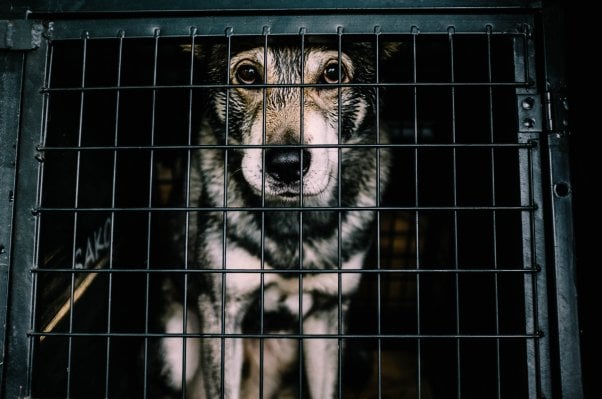Most of us are horrified by reports of dogs kept caged in puppy mills or laboratories—as well we should be. But if we’re honest, do our own canine companions have it much better? If they’re kept crated or locked in a bathroom, on a porch, or in an outdoor pen all day, not so much.
Dogs are social pack animals to their very core. Being separated from their families, locked inside a cage, and left alone day after day frustrates their innate need for companionship—something that is as vital to them as oxygen.
If you’re thinking of adopting a dog for your own companionship, but your work schedule or other obligations would require leaving the animal at home—without companionship—how is that fair?

It’s not uncommon for people who crate their dogs to keep them locked up for 18 hours or more a day: nine hours while at work (including commute time), another eight hours overnight, plus whenever they go out in the evening or on the weekend. All that confinement and isolation has a disastrous effect on dogs’ health and happiness.
Crating prevents dogs from fulfilling their basic needs, including moving around, relieving themselves, stretching, and interacting with and learning about their environment. Many crated dogs become severely depressed and withdrawn and can suffer from separation anxiety or even Stockholm syndrome. Hyperactivity and behavioral issues are other common consequences of crating. And if an emergency occurs while no one else is at home, crated dogs have no way of escaping. Some have burned to death or drowned, trapped inside their cages.
There is no need to lock dogs up like prisoners in their own homes. Humane, interactive training can resolve issues such as chewing on furniture or jumping on guests. What’s more, crating does not speed up the housetraining process. It can actually prolong it, because puppies can’t “hold it” for long, and having no choice but to soil their crates can make them lose their instinct to keep their surroundings clean.
If your lifestyle takes you away from home much of the time and you aren’t able to provide the attention and care the animal needs, please don’t adopt. It would be much kinder to volunteer to walk dogs or play with cats at your local shelter. Or, you could spend some of your free time working for animal rights. Volunteering at fundraisers, leafletting, and attending demonstrations are great ways to meet like-minded people while making a difference for animals.
If you’re sure that you have the time, resources, and love to care for an animal for life, consider adopting two compatible animals so they can keep each other company when you can’t be at home. Shelters often have pairs of animals who are already bonded and have ended up homeless after their guardians died or could no longer care for them. Adopting a bonded pair saves two lives and helps ensure that your new companions will get along harmoniously.

If you already have a dog and can’t adopt another one, consider starting a play group for lonely canines in your neighborhood. Some guardians who have only one dog even arrange to take turns letting their dogs spend the day at each other’s homes for companionship. (Make sure both dogs enjoy each other’s company and are completely comfortable together, and be sure to verify that your neighbor is responsible and trustworthy.)
No dog wants to be locked up. Dogs love their guardians, and they want to be part of the family, so let’s treat them that way. As veterinarian Dr. Michael W. Fox says, “People who claim to love their dogs and cage or crate them all day may not fully understand the nature of love or the love of dogs. Perhaps they should not have gotten a dog in the first place.”
Text VEG to 73822 to get the latest vegan lifestyle tips, recipes, and urgent action alerts texted right to your phone.
Terms for automated texts/calls from PETA: https://peta.vg/txt. Text STOP to end, HELP for more info. Msg/data rates may apply. U.S. only.



